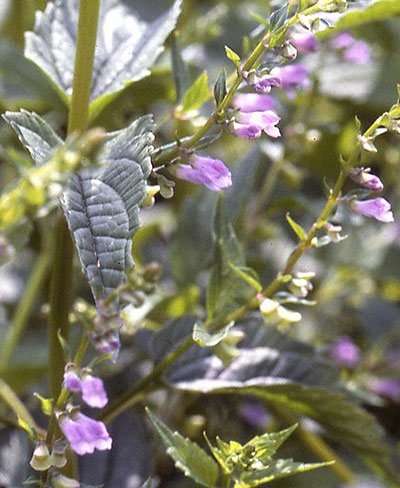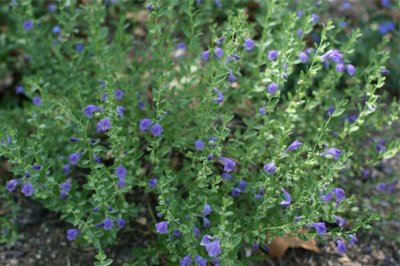Contents:
Common Names | Parts Usually Used | Plant(s) & Culture | Where Found | Medicinal Properties | Biochemical Information
Legends, Myths and Stories | Uses | Formulas or Dosages | How Sold | Warning | Bibliography
Scientific Names

- Scutellaria lateriflora L.
- Labiatae
- Mint family
Common Names
- American skullcap
- Blue pimpernel
- Blue skullcap
- Helmet flower
- Hooded willow herb
- Hoodwart
- Hoodwort
- Mad dog weed
- Mad weed
- Side flower
- Side-flowering skullcap
- Skullcap helmet flower
Parts Usually Used
Aerial parts
Back to Top
Description of Plant(s) and Culture

Skullcap is a North American perennial plant; the fibrous, yellow rootstock produces a branching stem from 1-3 feet high, with opposite, ovate, serrate leaves that come to a point.
The axillary, two-lipped flowers are pale purple or blue, blooming from July to September.
Another variety: The Chinese skullcap (Scutellaria macrantha) is called Huang-ch’in.
Back to Top
Where Found
Grows in wet places in Canada and the northern and eastern United States.
Found in damp, rich woods, moist thickets, meadows, and riversides; from Connecticut, south to Florida and Texas. Indigenous to North America.
Back to Top
Medicinal Properties
Alterative, antispasmodic, diuretic, sedative, tonic, nervine, slightly astringent
Back to Top
Biochemical Information
Fat, a bitter glycoside, iron, bitter principle, scutellarin, volatile oil, sugar, tannins, and vitamin E.
Back to Top
Legends, Myths and Stories
Known as Mad-dog skullcap because tea was once used as a folk remedy for rabies.
This herb was highly esteemed as an herb tea by the old time empirics and eclectics. Skullcap is still collected in the eastern mountains of Tennessee and Kentucky and hung in rafters to dry, ready for use when deemed necessary.
Back to Top
Uses
An infusion of skullcap is good for spasms and convulsions and for nervous conditions, it has a calming effect on the body, such as excitability, insomnia, hysteria, convulsions, tremors, epilepsy, hypertension, bed wetting, restlessness, stress, and general restlessness. It has also been recommended for rheumatism, rickets, palsy, nerualgia, chorea, snakebites, poisonous insect bites, and delirium tremens (DTs). Native Americans used the plant to promote menstruation, menstrual cramps, and it was reputed to be effective against rabies. It has been given to recovering alcoholics suffering from withdrawal symptoms.
Good for migraine headaches, epilepsy, and relieves pain, stress, neuralgia, neuritis, arthritis, muscle cramps, spasms. Improves circulation, strengthens the heart muscle, and aids sleep.
Useful in St. Vitus’s dance, shaking palsy, hydrophobia, bites of poisonous insects and snakes. Splendid to suppress excessive sexual desire.
As a substitute for quinine, skullcap is more effective and is not as harmful. Also, is a good brain tonic for promoting meditation.
This is one of the best herbs to use to break addictions and to ease the problems associated with drug and alcohol withdrawal. For such a condition, 1/4 to 1/2 a cupful of the tea should be taken every hour or two, tapering off as the symptoms subside. Skullcap is one of the herbs traditionally held to cure infertility.
The following combination is a positive remedy for wakefulness: equal parts skullcap, nerve root, hops, catnip, and black cohosh. Take a tbsp. of each, mix together, and use a heaping tsp. to 1 cup of boiling water. This combination is very useful in aiding a morphine addict to sleep.
Back to Top
Formulas or Dosages
Infusion: steep 1 tsp. dried plant in a cup of water for 30 minutes. Take 3-4 times a day.
Tincture: a dose is from 3-12 drops, taken in hot water.
Back to Top
How Sold
It should be noted that most of what is sold as skullcap in this country is germander (Teucrium). Ask for the genuine herb.
Capsules: take 1 capsule for up to 3 times daily.
Dried herb: mix 1 tbsp. herb with 8 oz. warm water. Drink 1 cup of the tea per day. May sweeten with honey and add lemon if desired.
Extract: mix 3 to 12 drops in liquid per day.
Back to Top
Warning
Large doses are of unknown toxicity.
Back to Top
Bibliography
![]() Back to Eden
Back to Eden, by Jethro Kloss; Back to Eden Publishing Co., Loma Linda, CA 92354, Original copyright 1939, revised edition 1994
![]() The Herb Book
The Herb Book, by John Lust, Bantam Books, 666 Fifth Avenue, New York, NY. copyright 1974.
 Old Ways Rediscovered
Old Ways Rediscovered, by Clarence Meyer, Meyerbooks, publisher, PO Box 427, Glenwood, Illinois 60425, published from 1954, print 1988
 Earl Mindell’s Herb Bible
Earl Mindell’s Herb Bible, by Earl Mindell, R.Ph., Ph.D., Simon & Schuster/Fireside, Rockefeller Center 1230 Avenue of the Americas, New York, New York 10020
![]() Chinese Medicinal Herbs
Chinese Medicinal Herbs, compiled by Shih-Chen Li, Georgetown Press, San Francisco, California, 1973.
![]() Indian Herbalogy of North America
Indian Herbalogy of North America, by Alma R. Hutchens, Shambala Publications, Inc., Horticultural Hall, 300 Massachusetts Avenue, Boston, Massachusetts 02115, 1973
![]() The Complete Medicinal Herbal
The Complete Medicinal Herbal, by Penelope Ody, Dorling Kindersley, Inc, 232 Madison Avenue, New York, NY 10016, First American Edition, copyright 1993
![]() Eastern/Central Medicinal Plants
Eastern/Central Medicinal Plants, by Steven Foster and James A. Duke., Houghton Mifflin Company, 215 Park Avenue South, New York, NY 10000
 The Magic of Herbs
The Magic of Herbs, by David Conway, published by Jonathan Cape, Thirty Bedford Square, London, England. (Out of print)
![]() Planetary Herbology
Planetary Herbology, by Michael Tierra, C.A., N.D., O.M.D., Lotus Press, PO Box 325, Twin Lakes. WI 53181., Copyright 1988, published 1992
![]() American Folk Medicine
American Folk Medicine, by Clarence Meyer, Meyerbooks, publisher, PO Box 427, Glenwood, Illinois 60425, 1973
![]() Prescription for Nutritional Healing, Fifth Edition: A Practical A-to-Z Reference to Drug-Free Remedies Using Vitamins, Minerals, Herbs & Food Supplements
Prescription for Nutritional Healing, Fifth Edition: A Practical A-to-Z Reference to Drug-Free Remedies Using Vitamins, Minerals, Herbs & Food Supplements, by James F. Balch, M.D. and Phyllis A. Balch, C.N.C., Avery Publishing Group, Inc., Garden City Park, NY
![]() The Yoga of Herbs: An Ayurvedic Guide to Herbal Medicine
The Yoga of Herbs: An Ayurvedic Guide to Herbal Medicine, by Dr. David Frawley & Dr. Vasant Lad, Lotus Press, Twin Lakes, Wisconsin, Second edition, 1988.
![]() Webster’s New World Dictionary
Webster’s New World Dictionary, Third College Edition, Victoria Neufeldt, Editor in Chief, New World Dictionaries: A Division of Simon & Schuster, Inc., 15 Columbus Circle, New York, NY 10023
 The Magic of Herbs in Daily Living
The Magic of Herbs in Daily Living, by Richard Lucas, Parker Publishing Co. (1988).
